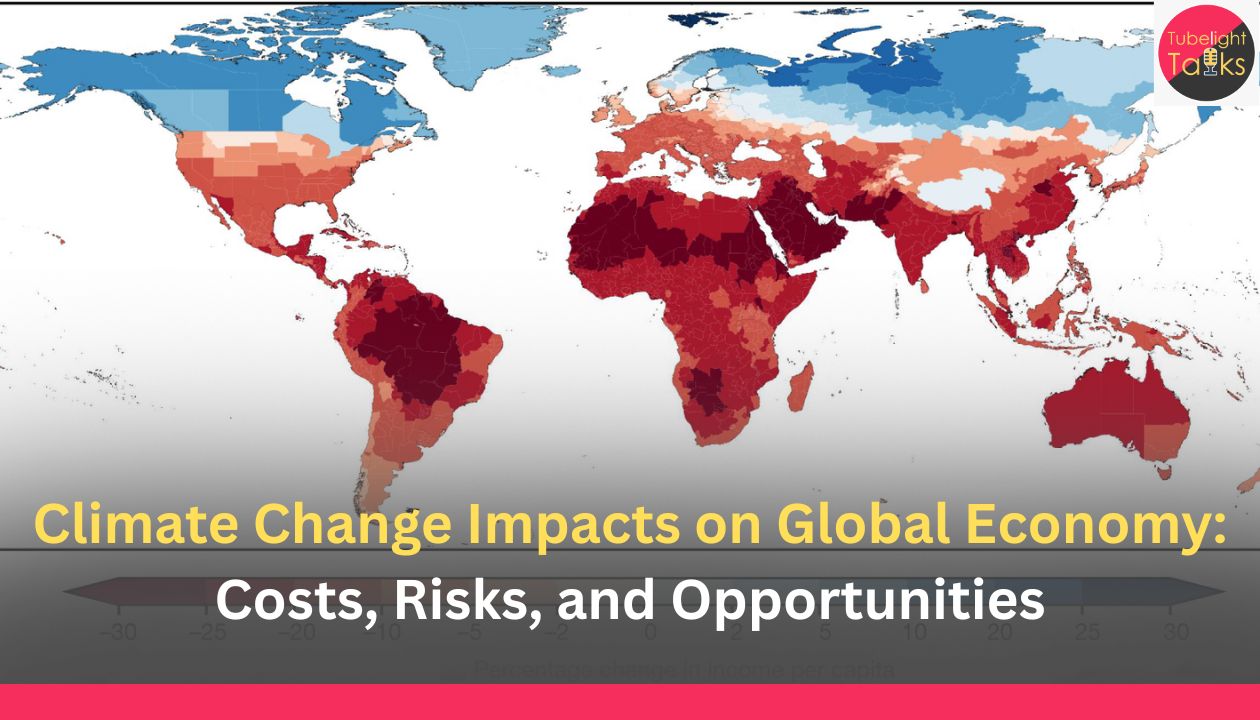Climate Change Impacts on Global Economy: Climate change is more than an environmental crisis—it’s a force rewriting the global economy’s future. From wildfires disrupting supply chains to floods submerging coastal infrastructure, extreme weather is already reshaping markets and livelihoods. The UN’s World Water Development Report highlights water stress threatening food and energy security for billions, while OECD research points to a silver lining: aggressive decarbonization could drive 60% GDP per capita growth in advanced economies by 2050. This blog dives into the economic toll—projected 19% global income losses in the coming decades (Nature, 2024)—while exploring sector-specific impacts and resilient strategies.
Backed by data from the World Bank, actuaries, and more, we’ll uncover how nations can turn crisis into opportunity. Whether you’re a policymaker, investor, or concerned citizen, understanding these shifts is crucial for building a sustainable future. Let’s explore the data and chart a path to prosperity.
Understanding Climate Change Impacts on Global Economy
Climate change imposes a hidden tax on global growth, amplifying risks through physical damages, policy transitions, and human adaptations. The World Bank’s Country Climate and Development Reports, covering 80 economies, estimate that unmitigated warming could shave 2-10% off annual GDP in vulnerable nations by 2030, driven by disruptions in agriculture, infrastructure, and labor productivity. Real-world impacts are already evident: the EU’s Copernicus program recorded a 1.5°C temperature breach, fueling events like Spain’s Valencia floods, which caused €1 billion in damages.
Key Impacts on Global GDP and Growth
The macroeconomic stakes are high. A 2024 Nature study projects a 19% global income reduction by 2050 (range: 11-29%), driven by temperature and precipitation extremes across 1,600+ regions over decades. The Institute and Faculty of Actuaries (IFoA) warns of up to 50% GDP losses between 2070-2090 without decarbonization and ecosystem restoration, factoring in tipping points like sea-level rise and mass migration. On the flip side, the OECD highlights that net-zero policies could boost GDP per capita by 124% in low-income countries by 2050, potentially lifting 175 million out of poverty by 2030 through green jobs and resilient infrastructure.
Sector-Specific Disruptions: Agriculture and Food Security
Agriculture, employing 27% of the global workforce, faces severe risks. The UN’s Global Report on Food Crises notes that climate extremes have driven food insecurity for 282 million people, with droughts cutting yields by 20-30% in sub-Saharan Africa. This translates to $1.2 trillion in annual losses by 2030 (World Bank), as rising temperatures reduce crop productivity—corn yields could drop 24% per 2°C rise (IPCC). Coastal rice paddies in Asia face salinization, threatening $500 billion in exports.
Supply Chain Vulnerabilities
Extreme weather disrupts global supply chains. Floods in Spain disrupted €10 billion in automotive exports, while Hurricane Helene in the US Southeast caused $50 billion in damages and halted 20% of regional manufacturing (NYT). Emerging markets, dependent on commodity trade, face up to 40% higher GDP losses when global weather spillovers are considered (CFR).
Infrastructure and Real Estate: The Hidden Costs
Physical assets are losing value fast. First Street projects $1.47 trillion in US real estate losses by 2055 from floods and fires. Globally, the Potsdam Institute estimates $38 trillion in annual costs by 2049, including $2 trillion for infrastructure repairs like ports submerged by 0.5m sea-level rise. Insurance premiums have surged 30% in high-risk zones (Swiss Re), deepening inequality by pricing out low-income households.
Energy Sector Shifts
The energy sector faces both risks and opportunities. Unchecked warming could add $1.5 trillion annually to energy demands for cooling (Morgan Stanley), but renewables are a bright spot. IRENA data shows clean energy created 1.5 million jobs in 2023, outpacing fossil fuels. However, transition costs could reach 2% of GDP in oil-dependent nations without subsidies, per World Bank finance reports.
Labor Markets and Human Capital: Productivity in Peril
Heat stress could cut 2.2% of global working hours by 2030, equating to $2.4 trillion in lost productivity (ILO). In tropical regions, extreme heat days have doubled since 2000, reducing outdoor worker efficiency by 10-15% (WESO Trends). Climate-driven migration—potentially 1.2 billion people by 2050 (IOM)—strains urban economies, boosting informal sectors but increasing social costs.
Health and Inequality Amplifiers
Climate-related health costs, including vector-borne diseases and respiratory issues, could reach $500 billion annually (EPA). Developing economies face 3-5x higher relative burdens (IMF), exacerbating debt cycles and inequality.
Mitigation and Adaptation: Pathways to Resilience
Proactive measures yield high returns. The OECD estimates that emissions peaking soon and cutting 43% by 2030 (UN) could avert $10 trillion in damages. Hybrid strategies like green bonds and nature-based solutions offer 4:1 returns (WEF’s State of Nature and Climate). Singapore’s $100 billion green plan, for example, cut emissions by 15% while creating 50,000 jobs.
Policy Imperatives and Global Cooperation
Achieving the Paris Agreement’s 2°C goal requires $4 trillion in annual investments (Morgan Stanley). Tools like carbon pricing (covering 25% of emissions) and World Bank aid of $50 billion guide global efforts. However, policy setbacks, like US rollbacks (NYT), highlight the need for stronger multilateral agreements.
Future Outlook: Tipping Points and Transformations
Without action, GDP could erode by 40% by 2100 (CFR), but innovations like VR modeling and blockchain-tracked carbon credits offer hope. The IMF calls for integrated models to assess real, fiscal, and financial risks, paving the way for transformative solutions.
Read Aalso: Climate Tipping Point Crossed: Global Coral Reefs Face Irreversible Collapse, Warn Scientists
Insights from Spiritual Wisdom: Balancing Nature and Prosperity
Climate change underscores the need for harmony with nature. Sant Rampal Ji Maharaj teaches, “The Earth is a divine gift; abusing it invites self-destruction, but revering it through discipline and truth unlocks eternal abundance.” Climate action, viewed through this lens, is a spiritual imperative—aligning green policies with ethical living to foster resilience and shared prosperity that honors the planet’s rhythm.
FAQs
Q1: What are the main economic impacts of climate change?
Impacts include a 19% global income reduction by 2050 (Nature, 2024), agriculture losses of $1.2 trillion annually (World Bank), and insurance costs rising 30% in high-risk zones.
Q2: How much could climate change cost the global economy by 2090?
Up to 50% GDP loss without action (IFoA), but mitigation could boost low-income GDP by 124% by 2050 (OECD).
Q3: Which sectors are most vulnerable to climate change economically?
Agriculture (20-30% yield drops), infrastructure ($38 trillion annual costs by 2049, Potsdam Institute), and labor (2.2% working hours lost by 2030, ILO).
Q4: Can fighting climate change grow the economy?
Yes—net-zero policies could increase advanced economies’ GDP per capita by 60% by 2050 and lift 175 million from poverty (OECD).
Q5: What role does international policy play in mitigating economic risks?
Emissions must peak soon and cut 43% by 2030 (UN); tools like carbon pricing and $50.8 billion in green finance (World Bank) are critical.










